The Link Between Diversification and CSR: The Case of Reliance India
VerifiedAdded on 2023/03/29
|106
|24686
|80
Thesis and Dissertation
AI Summary
This dissertation explores the relationship between diversification and Corporate Social Responsibility (CSR) within Reliance Industries Limited, an Indian conglomerate with diverse business sectors. It investigates strategic approaches, CSR initiatives, and their impact on the company's performance, social commitment, and environmental growth. The study uses an interpretivism philosophy, deductive approach, explanatory research design, and a case study strategy, supported by secondary data and qualitative analysis. It examines Reliance's diversification from telecom to energy, pharmaceuticals, textiles, and retail, alongside its CSR activities aimed at improving the environment and society. The research highlights the company's commitment to sustainable development, rural transformation, and women's education. The dissertation concludes with recommendations for enhancing Reliance's CSR activities and aligning them with its business objectives, emphasizing the importance of considering planet, profit, and people in the company's strategic decisions.

0
Running head: DISSERTATION
The link between diversification and CSR - The case of Reliance India
Name of the Student:
Name of the University:
Author’s Note:
Running head: DISSERTATION
The link between diversification and CSR - The case of Reliance India
Name of the Student:
Name of the University:
Author’s Note:
Paraphrase This Document
Need a fresh take? Get an instant paraphrase of this document with our AI Paraphraser
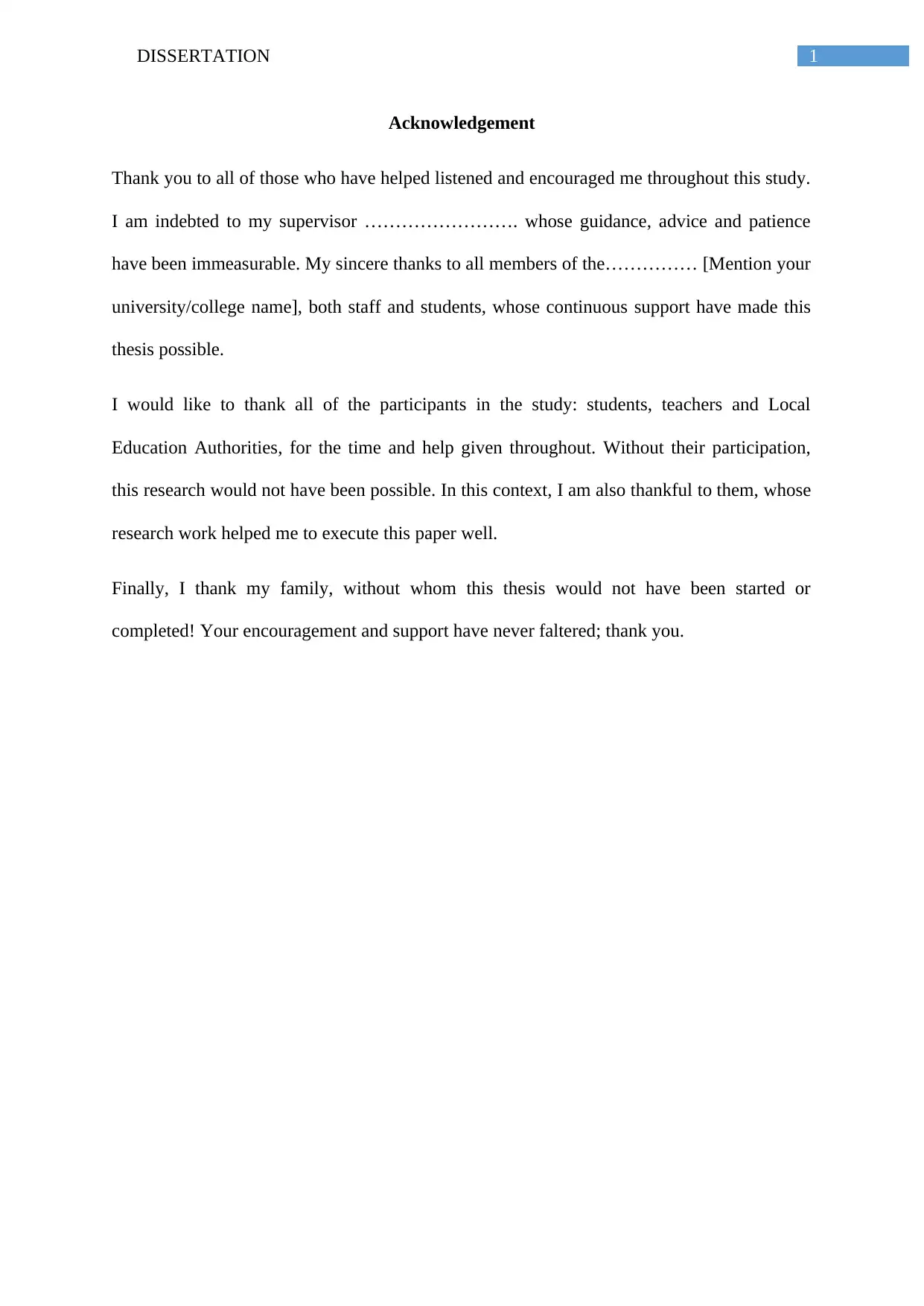
1DISSERTATION
Acknowledgement
Thank you to all of those who have helped listened and encouraged me throughout this study.
I am indebted to my supervisor ……………………. whose guidance, advice and patience
have been immeasurable. My sincere thanks to all members of the…………… [Mention your
university/college name], both staff and students, whose continuous support have made this
thesis possible.
I would like to thank all of the participants in the study: students, teachers and Local
Education Authorities, for the time and help given throughout. Without their participation,
this research would not have been possible. In this context, I am also thankful to them, whose
research work helped me to execute this paper well.
Finally, I thank my family, without whom this thesis would not have been started or
completed! Your encouragement and support have never faltered; thank you.
Acknowledgement
Thank you to all of those who have helped listened and encouraged me throughout this study.
I am indebted to my supervisor ……………………. whose guidance, advice and patience
have been immeasurable. My sincere thanks to all members of the…………… [Mention your
university/college name], both staff and students, whose continuous support have made this
thesis possible.
I would like to thank all of the participants in the study: students, teachers and Local
Education Authorities, for the time and help given throughout. Without their participation,
this research would not have been possible. In this context, I am also thankful to them, whose
research work helped me to execute this paper well.
Finally, I thank my family, without whom this thesis would not have been started or
completed! Your encouragement and support have never faltered; thank you.
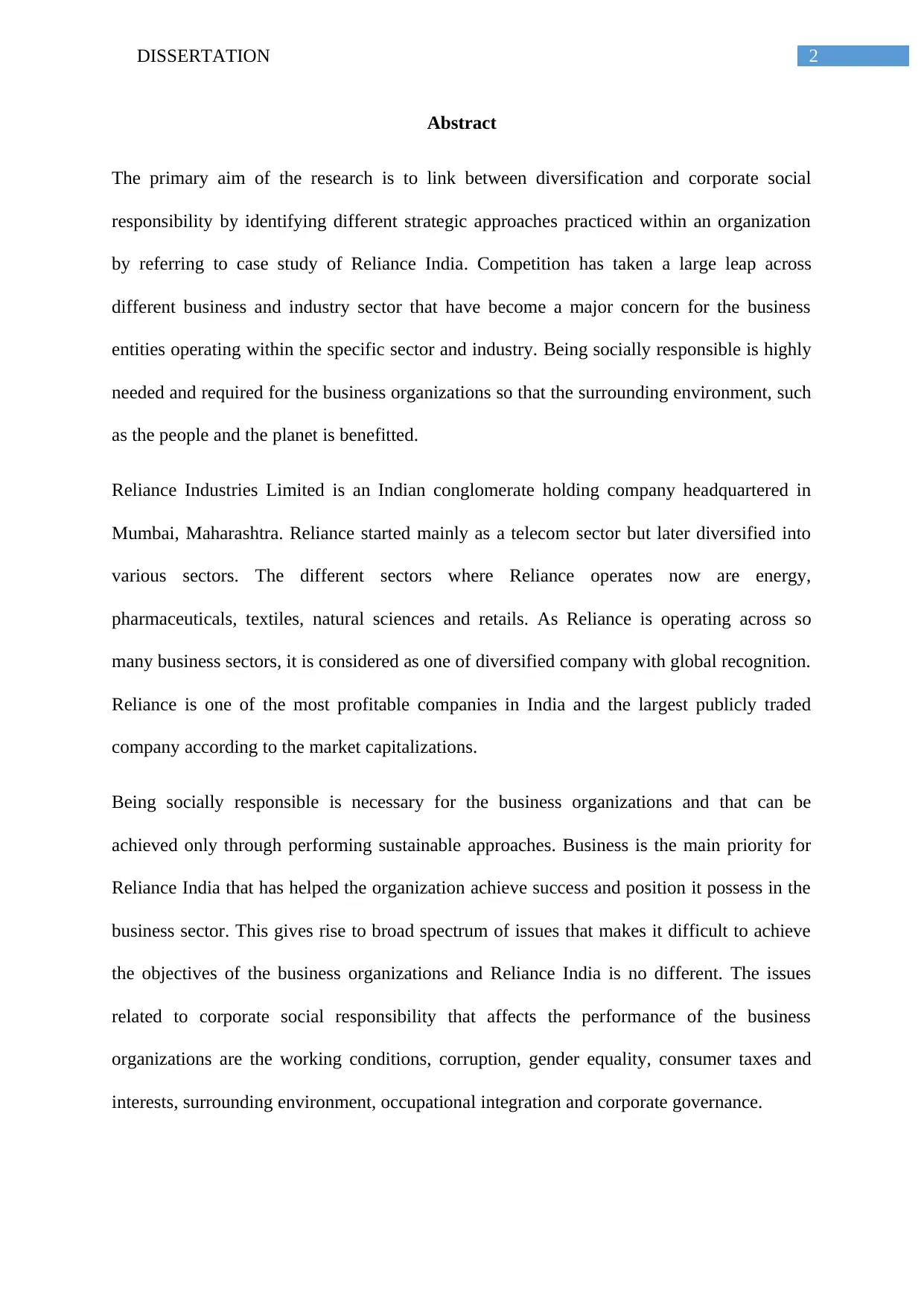
2DISSERTATION
Abstract
The primary aim of the research is to link between diversification and corporate social
responsibility by identifying different strategic approaches practiced within an organization
by referring to case study of Reliance India. Competition has taken a large leap across
different business and industry sector that have become a major concern for the business
entities operating within the specific sector and industry. Being socially responsible is highly
needed and required for the business organizations so that the surrounding environment, such
as the people and the planet is benefitted.
Reliance Industries Limited is an Indian conglomerate holding company headquartered in
Mumbai, Maharashtra. Reliance started mainly as a telecom sector but later diversified into
various sectors. The different sectors where Reliance operates now are energy,
pharmaceuticals, textiles, natural sciences and retails. As Reliance is operating across so
many business sectors, it is considered as one of diversified company with global recognition.
Reliance is one of the most profitable companies in India and the largest publicly traded
company according to the market capitalizations.
Being socially responsible is necessary for the business organizations and that can be
achieved only through performing sustainable approaches. Business is the main priority for
Reliance India that has helped the organization achieve success and position it possess in the
business sector. This gives rise to broad spectrum of issues that makes it difficult to achieve
the objectives of the business organizations and Reliance India is no different. The issues
related to corporate social responsibility that affects the performance of the business
organizations are the working conditions, corruption, gender equality, consumer taxes and
interests, surrounding environment, occupational integration and corporate governance.
Abstract
The primary aim of the research is to link between diversification and corporate social
responsibility by identifying different strategic approaches practiced within an organization
by referring to case study of Reliance India. Competition has taken a large leap across
different business and industry sector that have become a major concern for the business
entities operating within the specific sector and industry. Being socially responsible is highly
needed and required for the business organizations so that the surrounding environment, such
as the people and the planet is benefitted.
Reliance Industries Limited is an Indian conglomerate holding company headquartered in
Mumbai, Maharashtra. Reliance started mainly as a telecom sector but later diversified into
various sectors. The different sectors where Reliance operates now are energy,
pharmaceuticals, textiles, natural sciences and retails. As Reliance is operating across so
many business sectors, it is considered as one of diversified company with global recognition.
Reliance is one of the most profitable companies in India and the largest publicly traded
company according to the market capitalizations.
Being socially responsible is necessary for the business organizations and that can be
achieved only through performing sustainable approaches. Business is the main priority for
Reliance India that has helped the organization achieve success and position it possess in the
business sector. This gives rise to broad spectrum of issues that makes it difficult to achieve
the objectives of the business organizations and Reliance India is no different. The issues
related to corporate social responsibility that affects the performance of the business
organizations are the working conditions, corruption, gender equality, consumer taxes and
interests, surrounding environment, occupational integration and corporate governance.
⊘ This is a preview!⊘
Do you want full access?
Subscribe today to unlock all pages.

Trusted by 1+ million students worldwide
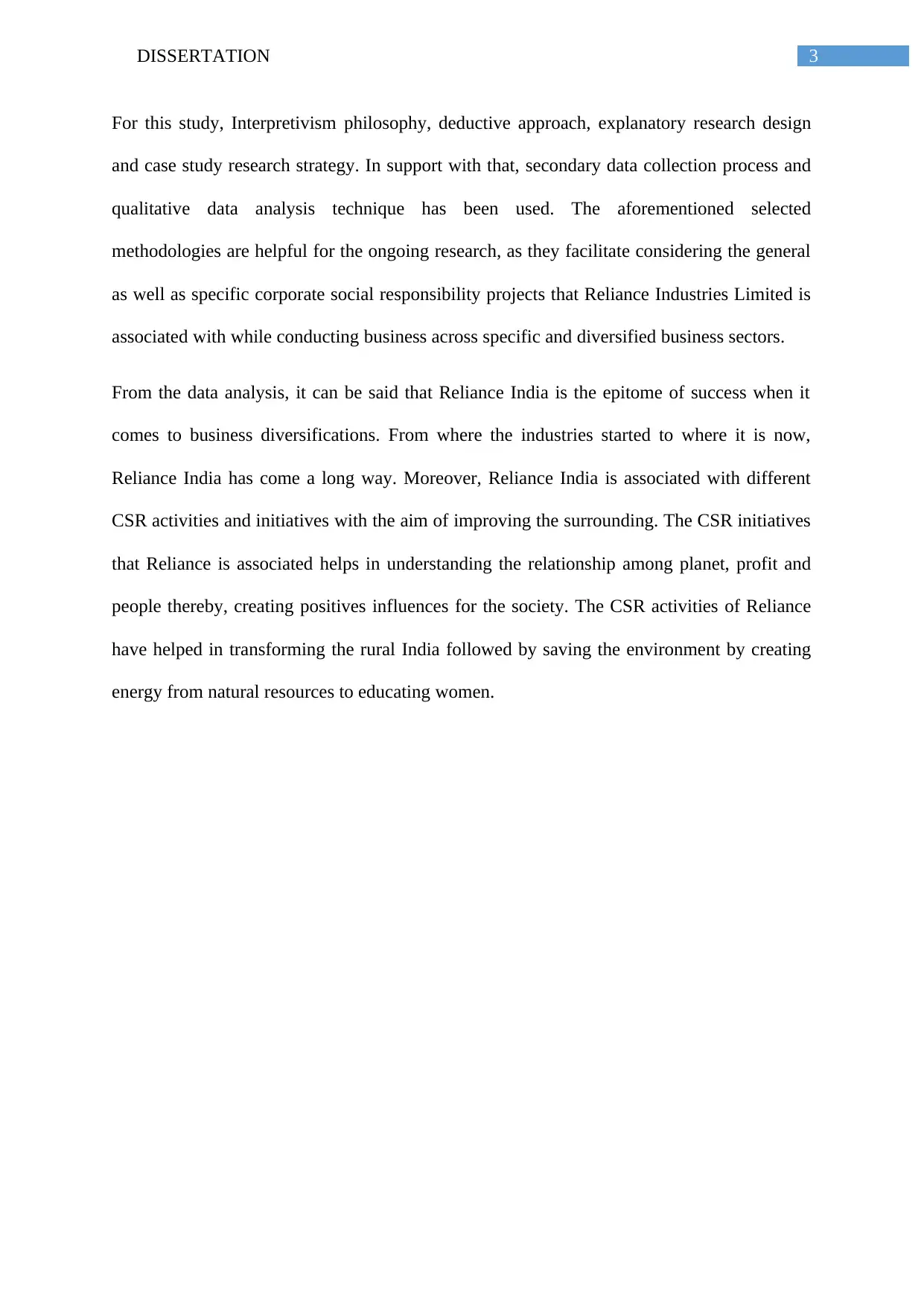
3DISSERTATION
For this study, Interpretivism philosophy, deductive approach, explanatory research design
and case study research strategy. In support with that, secondary data collection process and
qualitative data analysis technique has been used. The aforementioned selected
methodologies are helpful for the ongoing research, as they facilitate considering the general
as well as specific corporate social responsibility projects that Reliance Industries Limited is
associated with while conducting business across specific and diversified business sectors.
From the data analysis, it can be said that Reliance India is the epitome of success when it
comes to business diversifications. From where the industries started to where it is now,
Reliance India has come a long way. Moreover, Reliance India is associated with different
CSR activities and initiatives with the aim of improving the surrounding. The CSR initiatives
that Reliance is associated helps in understanding the relationship among planet, profit and
people thereby, creating positives influences for the society. The CSR activities of Reliance
have helped in transforming the rural India followed by saving the environment by creating
energy from natural resources to educating women.
For this study, Interpretivism philosophy, deductive approach, explanatory research design
and case study research strategy. In support with that, secondary data collection process and
qualitative data analysis technique has been used. The aforementioned selected
methodologies are helpful for the ongoing research, as they facilitate considering the general
as well as specific corporate social responsibility projects that Reliance Industries Limited is
associated with while conducting business across specific and diversified business sectors.
From the data analysis, it can be said that Reliance India is the epitome of success when it
comes to business diversifications. From where the industries started to where it is now,
Reliance India has come a long way. Moreover, Reliance India is associated with different
CSR activities and initiatives with the aim of improving the surrounding. The CSR initiatives
that Reliance is associated helps in understanding the relationship among planet, profit and
people thereby, creating positives influences for the society. The CSR activities of Reliance
have helped in transforming the rural India followed by saving the environment by creating
energy from natural resources to educating women.
Paraphrase This Document
Need a fresh take? Get an instant paraphrase of this document with our AI Paraphraser

4DISSERTATION
Table of Contents
Chapter 1: Introduction..............................................................................................................9
1.0 Overview..........................................................................................................................9
1.1 Problem statement..........................................................................................................10
1.2 Research aim..................................................................................................................12
1.3 Research objectives........................................................................................................12
1.4 Research questions.........................................................................................................12
1.5 Research rationale..........................................................................................................13
1.6 Structure of the dissertation...........................................................................................14
1.7 Summary........................................................................................................................15
Chapter 2: Literature review....................................................................................................16
2.0 Overview........................................................................................................................16
2.1 Diversification of business organizations......................................................................16
2.2 Factors influencing business organizations to diversify................................................17
2.2.1 Avoiding downturns................................................................................................17
2.2.2 Competitive defence................................................................................................18
2.2.3 Organizational improvement...................................................................................19
2.2.4 Minimizing company risk and increasing stability.................................................19
2.3 Benefits of organizational diversification......................................................................20
2.4 Challenges of business diversification...........................................................................22
Table of Contents
Chapter 1: Introduction..............................................................................................................9
1.0 Overview..........................................................................................................................9
1.1 Problem statement..........................................................................................................10
1.2 Research aim..................................................................................................................12
1.3 Research objectives........................................................................................................12
1.4 Research questions.........................................................................................................12
1.5 Research rationale..........................................................................................................13
1.6 Structure of the dissertation...........................................................................................14
1.7 Summary........................................................................................................................15
Chapter 2: Literature review....................................................................................................16
2.0 Overview........................................................................................................................16
2.1 Diversification of business organizations......................................................................16
2.2 Factors influencing business organizations to diversify................................................17
2.2.1 Avoiding downturns................................................................................................17
2.2.2 Competitive defence................................................................................................18
2.2.3 Organizational improvement...................................................................................19
2.2.4 Minimizing company risk and increasing stability.................................................19
2.3 Benefits of organizational diversification......................................................................20
2.4 Challenges of business diversification...........................................................................22
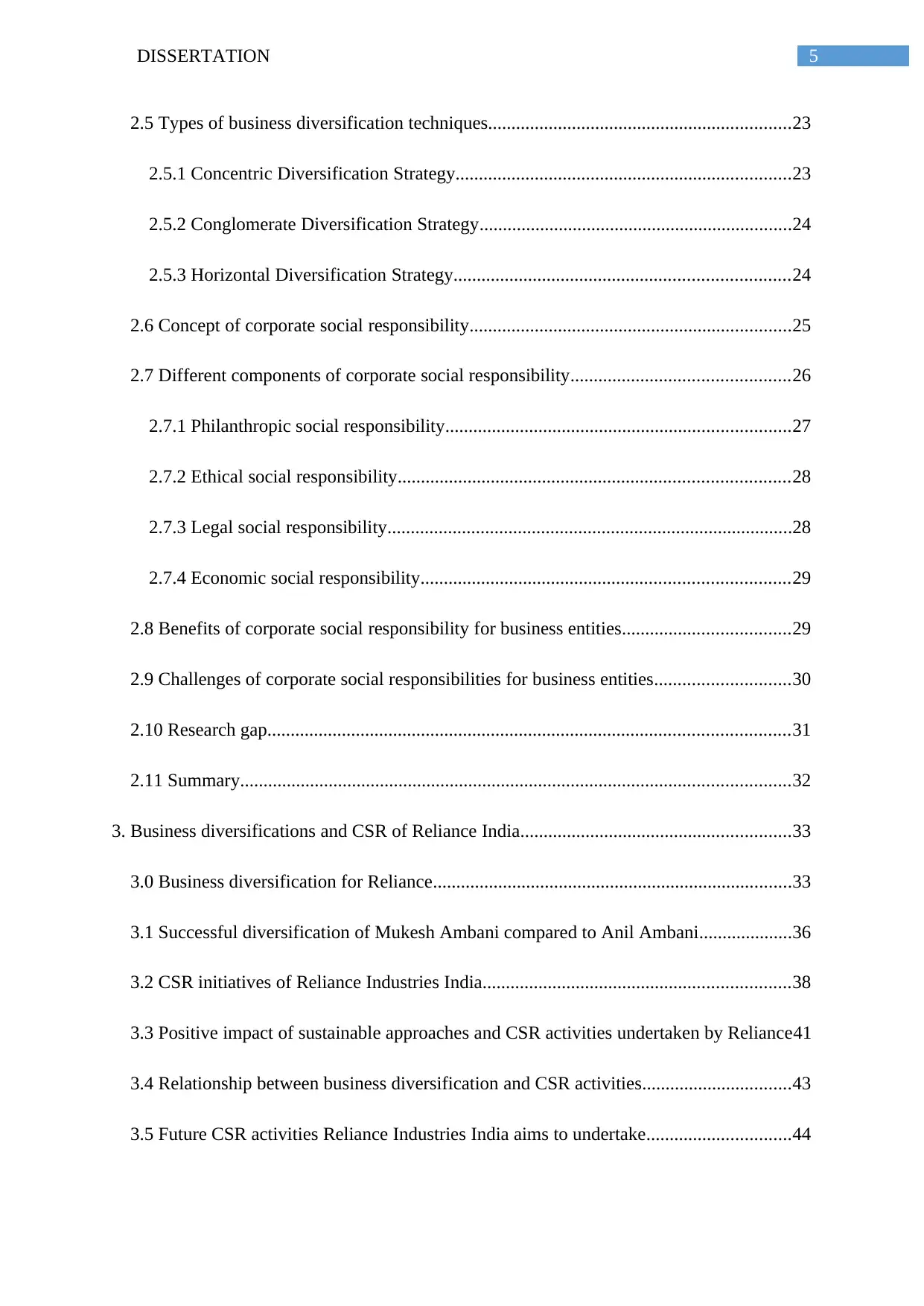
5DISSERTATION
2.5 Types of business diversification techniques.................................................................23
2.5.1 Concentric Diversification Strategy........................................................................23
2.5.2 Conglomerate Diversification Strategy...................................................................24
2.5.3 Horizontal Diversification Strategy........................................................................24
2.6 Concept of corporate social responsibility.....................................................................25
2.7 Different components of corporate social responsibility...............................................26
2.7.1 Philanthropic social responsibility..........................................................................27
2.7.2 Ethical social responsibility....................................................................................28
2.7.3 Legal social responsibility.......................................................................................28
2.7.4 Economic social responsibility...............................................................................29
2.8 Benefits of corporate social responsibility for business entities....................................29
2.9 Challenges of corporate social responsibilities for business entities.............................30
2.10 Research gap................................................................................................................31
2.11 Summary......................................................................................................................32
3. Business diversifications and CSR of Reliance India..........................................................33
3.0 Business diversification for Reliance.............................................................................33
3.1 Successful diversification of Mukesh Ambani compared to Anil Ambani....................36
3.2 CSR initiatives of Reliance Industries India..................................................................38
3.3 Positive impact of sustainable approaches and CSR activities undertaken by Reliance41
3.4 Relationship between business diversification and CSR activities................................43
3.5 Future CSR activities Reliance Industries India aims to undertake...............................44
2.5 Types of business diversification techniques.................................................................23
2.5.1 Concentric Diversification Strategy........................................................................23
2.5.2 Conglomerate Diversification Strategy...................................................................24
2.5.3 Horizontal Diversification Strategy........................................................................24
2.6 Concept of corporate social responsibility.....................................................................25
2.7 Different components of corporate social responsibility...............................................26
2.7.1 Philanthropic social responsibility..........................................................................27
2.7.2 Ethical social responsibility....................................................................................28
2.7.3 Legal social responsibility.......................................................................................28
2.7.4 Economic social responsibility...............................................................................29
2.8 Benefits of corporate social responsibility for business entities....................................29
2.9 Challenges of corporate social responsibilities for business entities.............................30
2.10 Research gap................................................................................................................31
2.11 Summary......................................................................................................................32
3. Business diversifications and CSR of Reliance India..........................................................33
3.0 Business diversification for Reliance.............................................................................33
3.1 Successful diversification of Mukesh Ambani compared to Anil Ambani....................36
3.2 CSR initiatives of Reliance Industries India..................................................................38
3.3 Positive impact of sustainable approaches and CSR activities undertaken by Reliance41
3.4 Relationship between business diversification and CSR activities................................43
3.5 Future CSR activities Reliance Industries India aims to undertake...............................44
⊘ This is a preview!⊘
Do you want full access?
Subscribe today to unlock all pages.

Trusted by 1+ million students worldwide
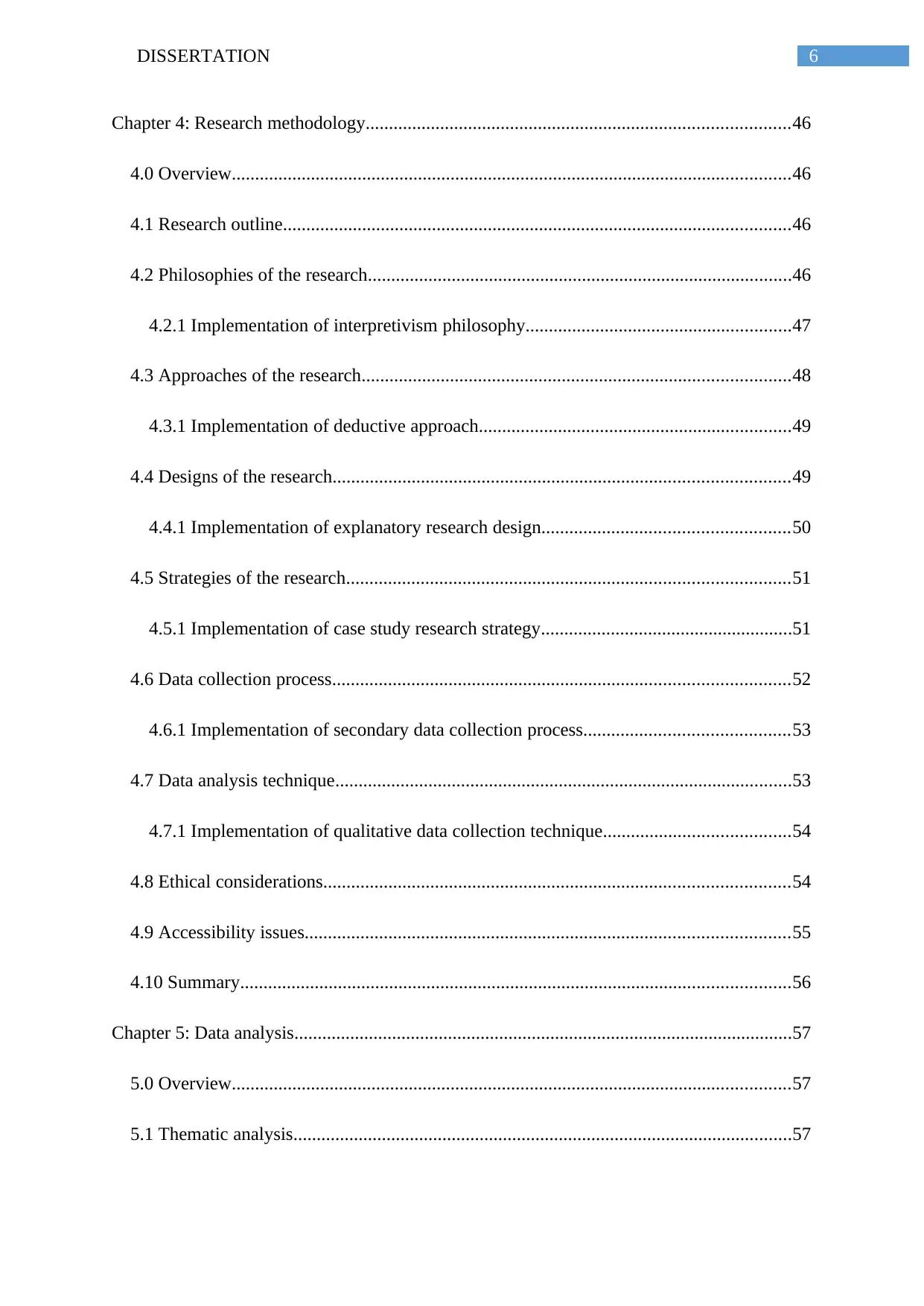
6DISSERTATION
Chapter 4: Research methodology...........................................................................................46
4.0 Overview........................................................................................................................46
4.1 Research outline.............................................................................................................46
4.2 Philosophies of the research...........................................................................................46
4.2.1 Implementation of interpretivism philosophy.........................................................47
4.3 Approaches of the research............................................................................................48
4.3.1 Implementation of deductive approach...................................................................49
4.4 Designs of the research..................................................................................................49
4.4.1 Implementation of explanatory research design.....................................................50
4.5 Strategies of the research...............................................................................................51
4.5.1 Implementation of case study research strategy......................................................51
4.6 Data collection process..................................................................................................52
4.6.1 Implementation of secondary data collection process............................................53
4.7 Data analysis technique..................................................................................................53
4.7.1 Implementation of qualitative data collection technique........................................54
4.8 Ethical considerations....................................................................................................54
4.9 Accessibility issues........................................................................................................55
4.10 Summary......................................................................................................................56
Chapter 5: Data analysis...........................................................................................................57
5.0 Overview........................................................................................................................57
5.1 Thematic analysis...........................................................................................................57
Chapter 4: Research methodology...........................................................................................46
4.0 Overview........................................................................................................................46
4.1 Research outline.............................................................................................................46
4.2 Philosophies of the research...........................................................................................46
4.2.1 Implementation of interpretivism philosophy.........................................................47
4.3 Approaches of the research............................................................................................48
4.3.1 Implementation of deductive approach...................................................................49
4.4 Designs of the research..................................................................................................49
4.4.1 Implementation of explanatory research design.....................................................50
4.5 Strategies of the research...............................................................................................51
4.5.1 Implementation of case study research strategy......................................................51
4.6 Data collection process..................................................................................................52
4.6.1 Implementation of secondary data collection process............................................53
4.7 Data analysis technique..................................................................................................53
4.7.1 Implementation of qualitative data collection technique........................................54
4.8 Ethical considerations....................................................................................................54
4.9 Accessibility issues........................................................................................................55
4.10 Summary......................................................................................................................56
Chapter 5: Data analysis...........................................................................................................57
5.0 Overview........................................................................................................................57
5.1 Thematic analysis...........................................................................................................57
Paraphrase This Document
Need a fresh take? Get an instant paraphrase of this document with our AI Paraphraser
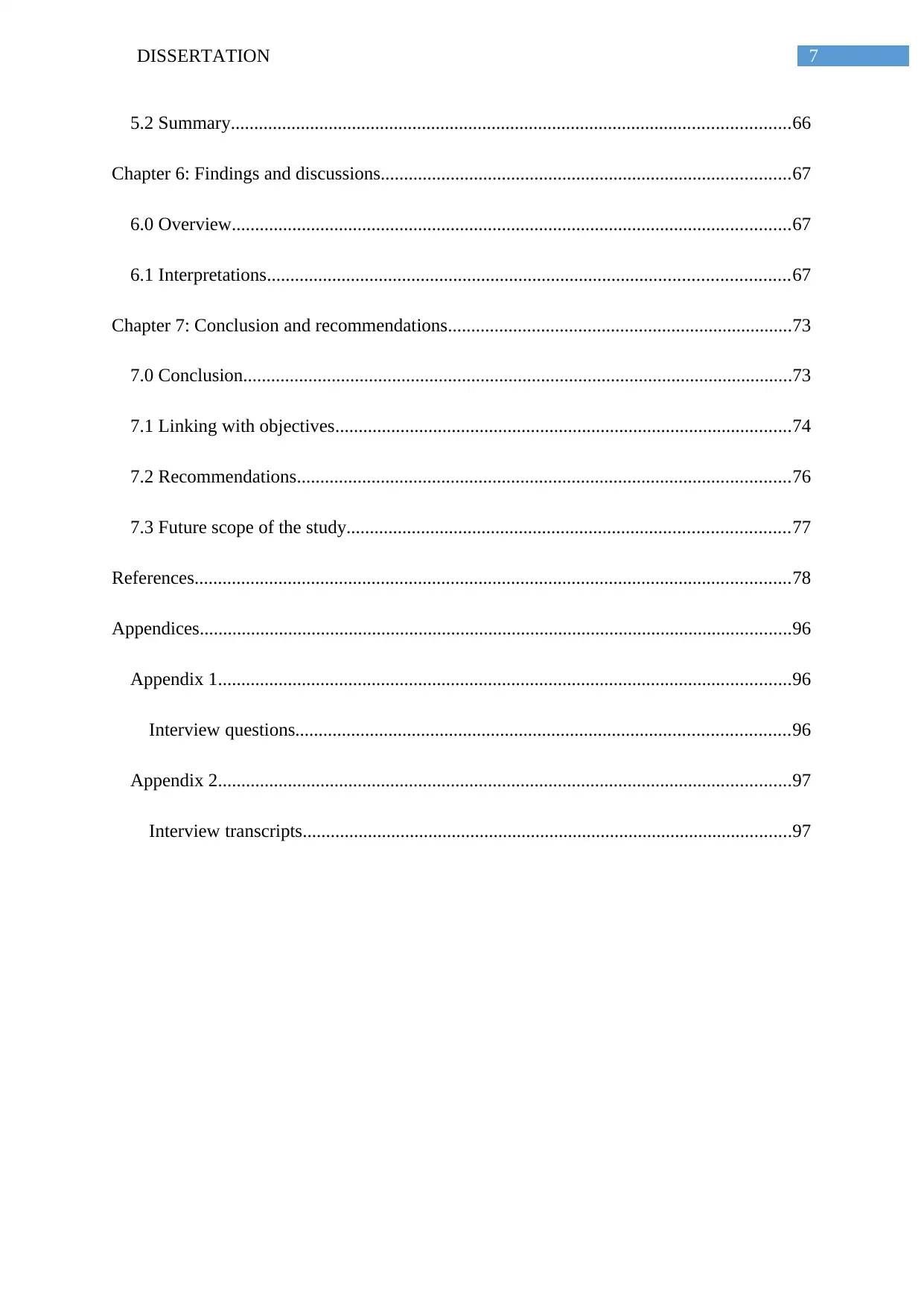
7DISSERTATION
5.2 Summary........................................................................................................................66
Chapter 6: Findings and discussions........................................................................................67
6.0 Overview........................................................................................................................67
6.1 Interpretations................................................................................................................67
Chapter 7: Conclusion and recommendations..........................................................................73
7.0 Conclusion......................................................................................................................73
7.1 Linking with objectives..................................................................................................74
7.2 Recommendations..........................................................................................................76
7.3 Future scope of the study...............................................................................................77
References................................................................................................................................78
Appendices...............................................................................................................................96
Appendix 1...........................................................................................................................96
Interview questions..........................................................................................................96
Appendix 2...........................................................................................................................97
Interview transcripts.........................................................................................................97
5.2 Summary........................................................................................................................66
Chapter 6: Findings and discussions........................................................................................67
6.0 Overview........................................................................................................................67
6.1 Interpretations................................................................................................................67
Chapter 7: Conclusion and recommendations..........................................................................73
7.0 Conclusion......................................................................................................................73
7.1 Linking with objectives..................................................................................................74
7.2 Recommendations..........................................................................................................76
7.3 Future scope of the study...............................................................................................77
References................................................................................................................................78
Appendices...............................................................................................................................96
Appendix 1...........................................................................................................................96
Interview questions..........................................................................................................96
Appendix 2...........................................................................................................................97
Interview transcripts.........................................................................................................97
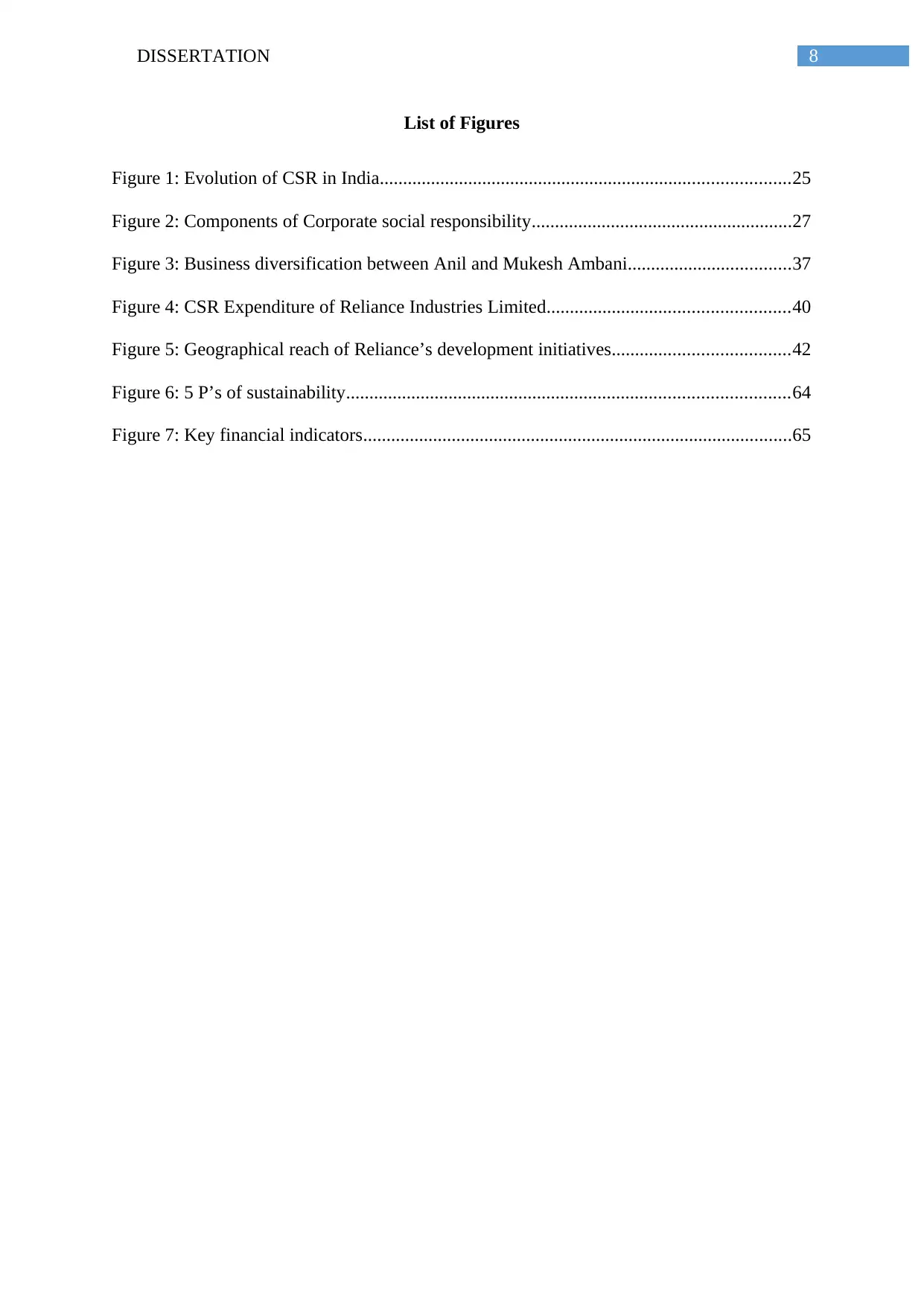
8DISSERTATION
List of Figures
Figure 1: Evolution of CSR in India........................................................................................25
Figure 2: Components of Corporate social responsibility........................................................27
Figure 3: Business diversification between Anil and Mukesh Ambani...................................37
Figure 4: CSR Expenditure of Reliance Industries Limited....................................................40
Figure 5: Geographical reach of Reliance’s development initiatives......................................42
Figure 6: 5 P’s of sustainability...............................................................................................64
Figure 7: Key financial indicators............................................................................................65
List of Figures
Figure 1: Evolution of CSR in India........................................................................................25
Figure 2: Components of Corporate social responsibility........................................................27
Figure 3: Business diversification between Anil and Mukesh Ambani...................................37
Figure 4: CSR Expenditure of Reliance Industries Limited....................................................40
Figure 5: Geographical reach of Reliance’s development initiatives......................................42
Figure 6: 5 P’s of sustainability...............................................................................................64
Figure 7: Key financial indicators............................................................................................65
⊘ This is a preview!⊘
Do you want full access?
Subscribe today to unlock all pages.

Trusted by 1+ million students worldwide
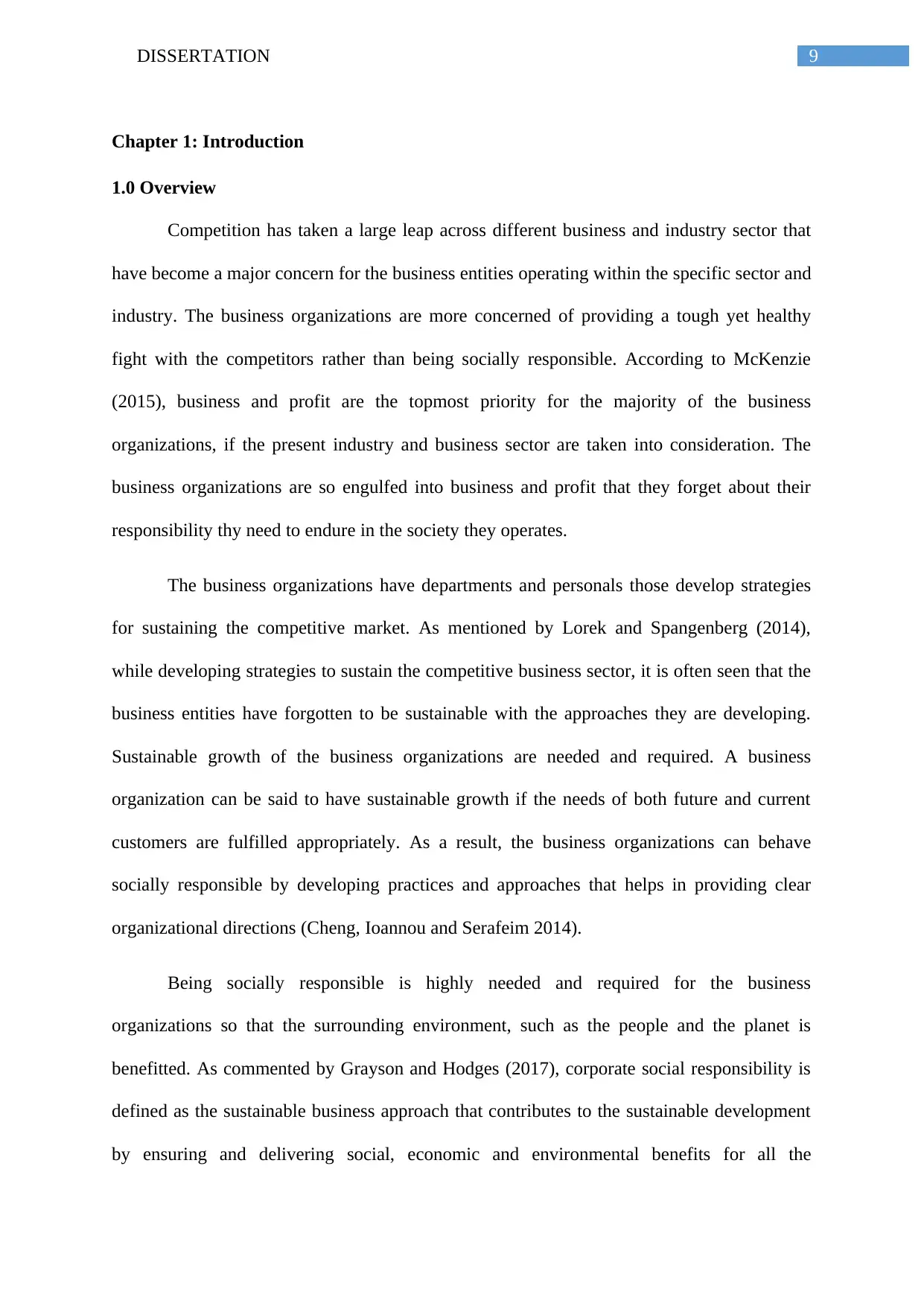
9DISSERTATION
Chapter 1: Introduction
1.0 Overview
Competition has taken a large leap across different business and industry sector that
have become a major concern for the business entities operating within the specific sector and
industry. The business organizations are more concerned of providing a tough yet healthy
fight with the competitors rather than being socially responsible. According to McKenzie
(2015), business and profit are the topmost priority for the majority of the business
organizations, if the present industry and business sector are taken into consideration. The
business organizations are so engulfed into business and profit that they forget about their
responsibility thy need to endure in the society they operates.
The business organizations have departments and personals those develop strategies
for sustaining the competitive market. As mentioned by Lorek and Spangenberg (2014),
while developing strategies to sustain the competitive business sector, it is often seen that the
business entities have forgotten to be sustainable with the approaches they are developing.
Sustainable growth of the business organizations are needed and required. A business
organization can be said to have sustainable growth if the needs of both future and current
customers are fulfilled appropriately. As a result, the business organizations can behave
socially responsible by developing practices and approaches that helps in providing clear
organizational directions (Cheng, Ioannou and Serafeim 2014).
Being socially responsible is highly needed and required for the business
organizations so that the surrounding environment, such as the people and the planet is
benefitted. As commented by Grayson and Hodges (2017), corporate social responsibility is
defined as the sustainable business approach that contributes to the sustainable development
by ensuring and delivering social, economic and environmental benefits for all the
Chapter 1: Introduction
1.0 Overview
Competition has taken a large leap across different business and industry sector that
have become a major concern for the business entities operating within the specific sector and
industry. The business organizations are more concerned of providing a tough yet healthy
fight with the competitors rather than being socially responsible. According to McKenzie
(2015), business and profit are the topmost priority for the majority of the business
organizations, if the present industry and business sector are taken into consideration. The
business organizations are so engulfed into business and profit that they forget about their
responsibility thy need to endure in the society they operates.
The business organizations have departments and personals those develop strategies
for sustaining the competitive market. As mentioned by Lorek and Spangenberg (2014),
while developing strategies to sustain the competitive business sector, it is often seen that the
business entities have forgotten to be sustainable with the approaches they are developing.
Sustainable growth of the business organizations are needed and required. A business
organization can be said to have sustainable growth if the needs of both future and current
customers are fulfilled appropriately. As a result, the business organizations can behave
socially responsible by developing practices and approaches that helps in providing clear
organizational directions (Cheng, Ioannou and Serafeim 2014).
Being socially responsible is highly needed and required for the business
organizations so that the surrounding environment, such as the people and the planet is
benefitted. As commented by Grayson and Hodges (2017), corporate social responsibility is
defined as the sustainable business approach that contributes to the sustainable development
by ensuring and delivering social, economic and environmental benefits for all the
Paraphrase This Document
Need a fresh take? Get an instant paraphrase of this document with our AI Paraphraser
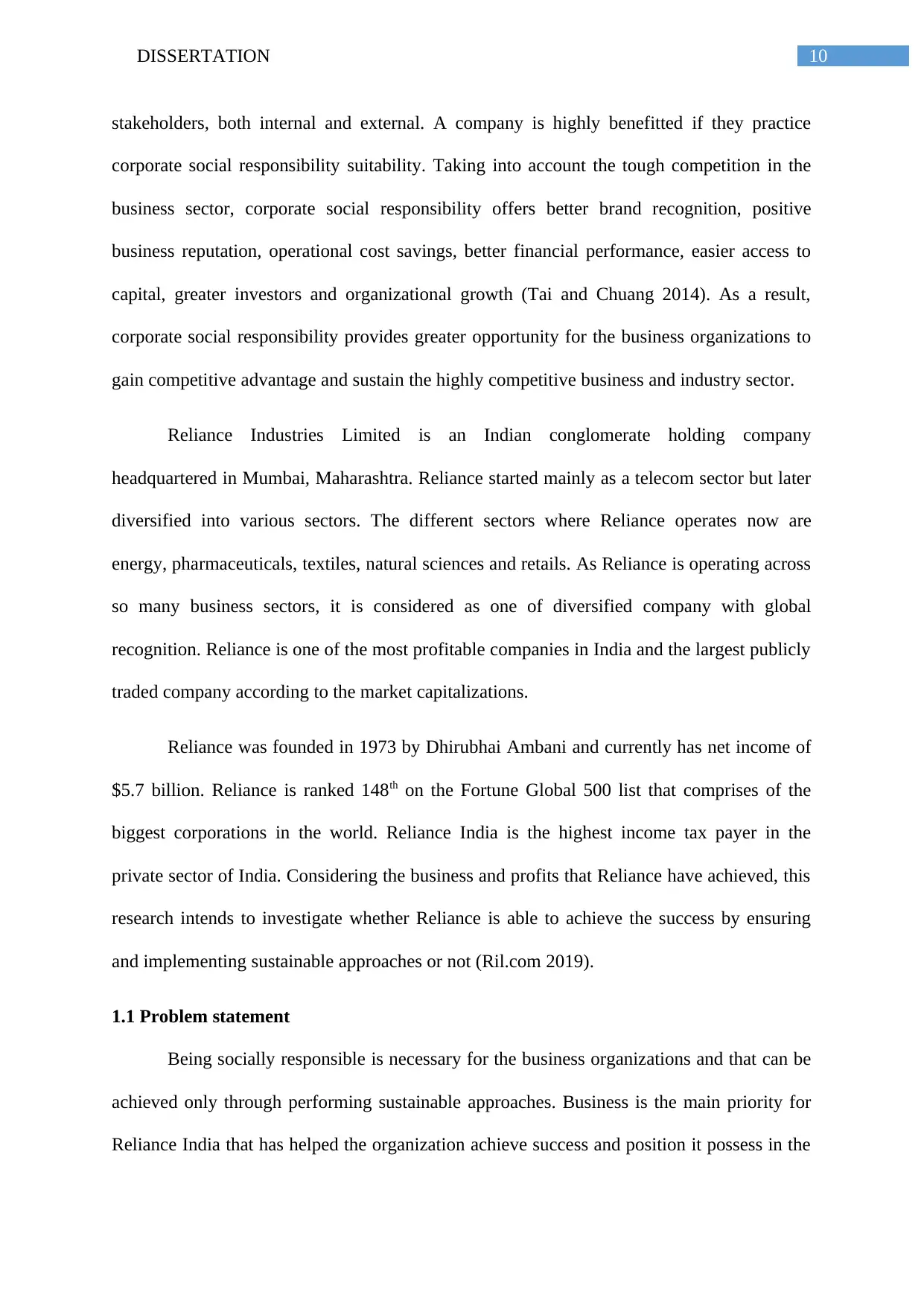
10DISSERTATION
stakeholders, both internal and external. A company is highly benefitted if they practice
corporate social responsibility suitability. Taking into account the tough competition in the
business sector, corporate social responsibility offers better brand recognition, positive
business reputation, operational cost savings, better financial performance, easier access to
capital, greater investors and organizational growth (Tai and Chuang 2014). As a result,
corporate social responsibility provides greater opportunity for the business organizations to
gain competitive advantage and sustain the highly competitive business and industry sector.
Reliance Industries Limited is an Indian conglomerate holding company
headquartered in Mumbai, Maharashtra. Reliance started mainly as a telecom sector but later
diversified into various sectors. The different sectors where Reliance operates now are
energy, pharmaceuticals, textiles, natural sciences and retails. As Reliance is operating across
so many business sectors, it is considered as one of diversified company with global
recognition. Reliance is one of the most profitable companies in India and the largest publicly
traded company according to the market capitalizations.
Reliance was founded in 1973 by Dhirubhai Ambani and currently has net income of
$5.7 billion. Reliance is ranked 148th on the Fortune Global 500 list that comprises of the
biggest corporations in the world. Reliance India is the highest income tax payer in the
private sector of India. Considering the business and profits that Reliance have achieved, this
research intends to investigate whether Reliance is able to achieve the success by ensuring
and implementing sustainable approaches or not (Ril.com 2019).
1.1 Problem statement
Being socially responsible is necessary for the business organizations and that can be
achieved only through performing sustainable approaches. Business is the main priority for
Reliance India that has helped the organization achieve success and position it possess in the
stakeholders, both internal and external. A company is highly benefitted if they practice
corporate social responsibility suitability. Taking into account the tough competition in the
business sector, corporate social responsibility offers better brand recognition, positive
business reputation, operational cost savings, better financial performance, easier access to
capital, greater investors and organizational growth (Tai and Chuang 2014). As a result,
corporate social responsibility provides greater opportunity for the business organizations to
gain competitive advantage and sustain the highly competitive business and industry sector.
Reliance Industries Limited is an Indian conglomerate holding company
headquartered in Mumbai, Maharashtra. Reliance started mainly as a telecom sector but later
diversified into various sectors. The different sectors where Reliance operates now are
energy, pharmaceuticals, textiles, natural sciences and retails. As Reliance is operating across
so many business sectors, it is considered as one of diversified company with global
recognition. Reliance is one of the most profitable companies in India and the largest publicly
traded company according to the market capitalizations.
Reliance was founded in 1973 by Dhirubhai Ambani and currently has net income of
$5.7 billion. Reliance is ranked 148th on the Fortune Global 500 list that comprises of the
biggest corporations in the world. Reliance India is the highest income tax payer in the
private sector of India. Considering the business and profits that Reliance have achieved, this
research intends to investigate whether Reliance is able to achieve the success by ensuring
and implementing sustainable approaches or not (Ril.com 2019).
1.1 Problem statement
Being socially responsible is necessary for the business organizations and that can be
achieved only through performing sustainable approaches. Business is the main priority for
Reliance India that has helped the organization achieve success and position it possess in the
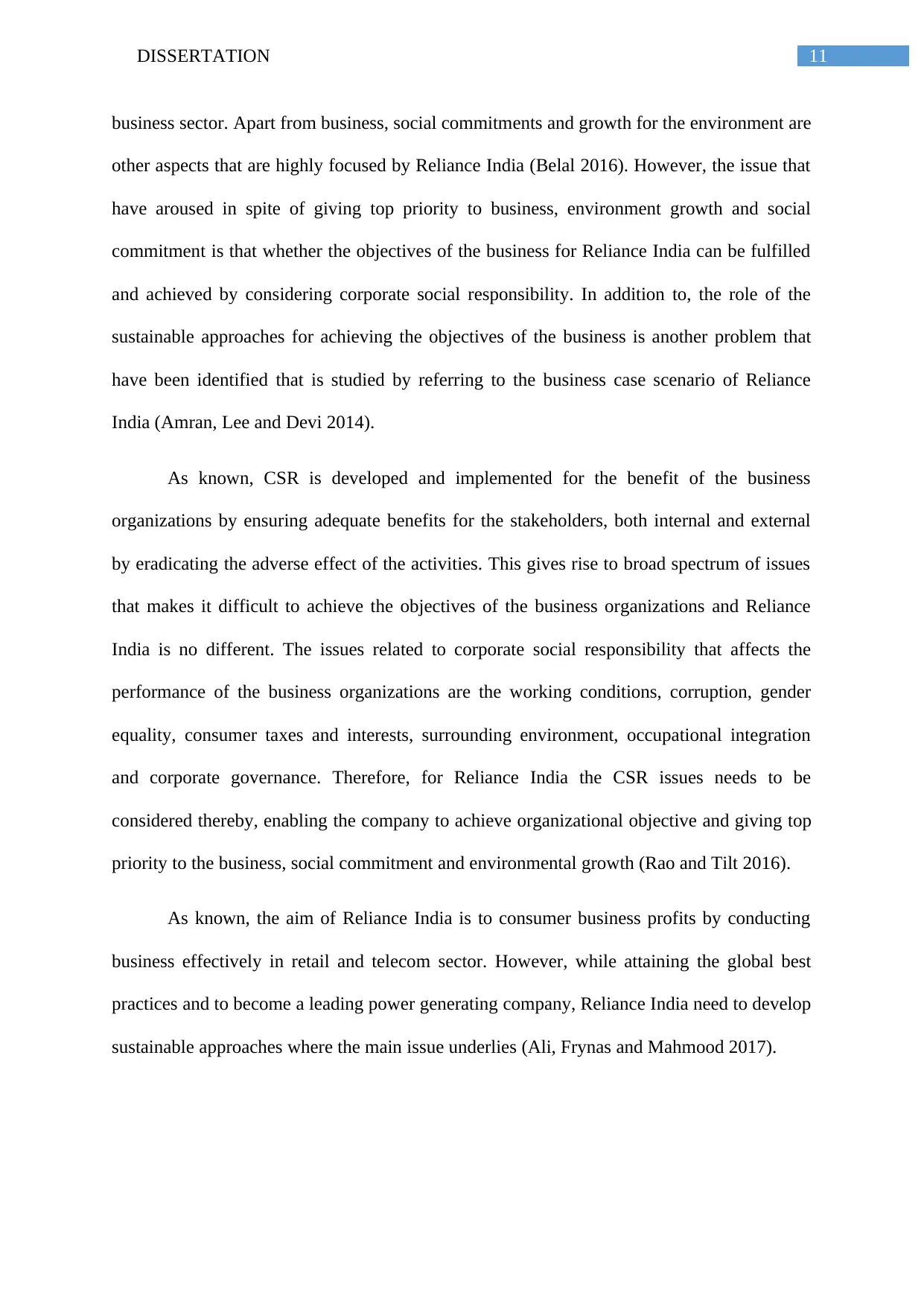
11DISSERTATION
business sector. Apart from business, social commitments and growth for the environment are
other aspects that are highly focused by Reliance India (Belal 2016). However, the issue that
have aroused in spite of giving top priority to business, environment growth and social
commitment is that whether the objectives of the business for Reliance India can be fulfilled
and achieved by considering corporate social responsibility. In addition to, the role of the
sustainable approaches for achieving the objectives of the business is another problem that
have been identified that is studied by referring to the business case scenario of Reliance
India (Amran, Lee and Devi 2014).
As known, CSR is developed and implemented for the benefit of the business
organizations by ensuring adequate benefits for the stakeholders, both internal and external
by eradicating the adverse effect of the activities. This gives rise to broad spectrum of issues
that makes it difficult to achieve the objectives of the business organizations and Reliance
India is no different. The issues related to corporate social responsibility that affects the
performance of the business organizations are the working conditions, corruption, gender
equality, consumer taxes and interests, surrounding environment, occupational integration
and corporate governance. Therefore, for Reliance India the CSR issues needs to be
considered thereby, enabling the company to achieve organizational objective and giving top
priority to the business, social commitment and environmental growth (Rao and Tilt 2016).
As known, the aim of Reliance India is to consumer business profits by conducting
business effectively in retail and telecom sector. However, while attaining the global best
practices and to become a leading power generating company, Reliance India need to develop
sustainable approaches where the main issue underlies (Ali, Frynas and Mahmood 2017).
business sector. Apart from business, social commitments and growth for the environment are
other aspects that are highly focused by Reliance India (Belal 2016). However, the issue that
have aroused in spite of giving top priority to business, environment growth and social
commitment is that whether the objectives of the business for Reliance India can be fulfilled
and achieved by considering corporate social responsibility. In addition to, the role of the
sustainable approaches for achieving the objectives of the business is another problem that
have been identified that is studied by referring to the business case scenario of Reliance
India (Amran, Lee and Devi 2014).
As known, CSR is developed and implemented for the benefit of the business
organizations by ensuring adequate benefits for the stakeholders, both internal and external
by eradicating the adverse effect of the activities. This gives rise to broad spectrum of issues
that makes it difficult to achieve the objectives of the business organizations and Reliance
India is no different. The issues related to corporate social responsibility that affects the
performance of the business organizations are the working conditions, corruption, gender
equality, consumer taxes and interests, surrounding environment, occupational integration
and corporate governance. Therefore, for Reliance India the CSR issues needs to be
considered thereby, enabling the company to achieve organizational objective and giving top
priority to the business, social commitment and environmental growth (Rao and Tilt 2016).
As known, the aim of Reliance India is to consumer business profits by conducting
business effectively in retail and telecom sector. However, while attaining the global best
practices and to become a leading power generating company, Reliance India need to develop
sustainable approaches where the main issue underlies (Ali, Frynas and Mahmood 2017).
⊘ This is a preview!⊘
Do you want full access?
Subscribe today to unlock all pages.

Trusted by 1+ million students worldwide
1 out of 106
Related Documents
Your All-in-One AI-Powered Toolkit for Academic Success.
+13062052269
info@desklib.com
Available 24*7 on WhatsApp / Email
![[object Object]](/_next/static/media/star-bottom.7253800d.svg)
Unlock your academic potential
Copyright © 2020–2025 A2Z Services. All Rights Reserved. Developed and managed by ZUCOL.





